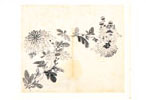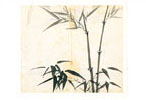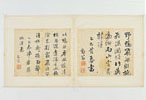Exhibition Gallery
Calligraphy and Paintings
YEUNGNAM UNIVERSITY MUSEUM collects various kinds of ancient paintings. Compared with other museums, the university museum owns more practical paintings and picture writings than general appreciable paintings. The museum is especially famous for its collections of ancient maps and wooden printing plates. In addition, only Yeungnam University Museum owns the Empress Dangyeong's Folding Screens Painted of the Scenes of the Nine Valleys of Mount Wuyi in China, a folk painting, Ten Folding Screens Painted of Colorful Flowers and Various Birds donated by Gansong, the portraits of great Buddhist priests in the Joseon Period such as Samyeongdang, and many other masterpieces of paintings and calligraphies in the late Joseon donated by Ojeong. Other outstanding acquisitions include, Ten Folding Screens Painted of Bamboo Nodding in the Wind by Suun Yu Deokjang, as well as the Four Gracious Plants by Pyoam Gang Sehwang, a fine piece of art representing the four gracious plants in the Joseon Period.
YEUNGNAM UNIVERSITY MUSEUM owns the largest collection of ancient Korean maps in the world. There is the Dongram Map drawn in the late 16th Century, the Daedong World Map, an accurate map produced by cartographer Gim Jeongho, various maps of Korea (Donggukdo), the Gunhyeon Map which represented regions and counties, the Gwangbang Map which represents national borders and military fortresses, picture writings called the History Map, the Pictorial Map of the Universe, a small portable atlas called Sujin Map, and other maps made by Japanese Imperialists to colonize the Korean Peninsula. Ancient Korean maps reflect our ancestors' idea of the land, geological knowledge, as well as knowledge of society and economy. At the same time, ancient painting skills are demonstrated. Because of these factors, ancient maps yield important information about our cultural history.
YEUNGNAM UNIVERSITY MUSEUM owns fine works of calligraphies. Eight Folding Screens Decorated with Transcriptions of Gwak Yudo's Epitaph, written in ornamental square character style, House of Poetry with an Ink Slab and Bamboo Brazier, and letters written in calligraphy are masterpieces of Chusa Gim Jeonghi from the late Joseon Period.
Also from the same era, are fine works of calligraphies by Yeongjo the Great, Toegye Yi Hwang, Bak Munsu, and other masters of calligraphy such as Wongyo Yi Gwangsa and Cheongam Yi Samman.
Wood printing plates for the cover of an ancient book from the Joseon Period is famous for its delicate and beautiful design. There are various kinds of wood printing plates at the museum. Of these, some plates are considered the most outstanding masterpieces in the country.



